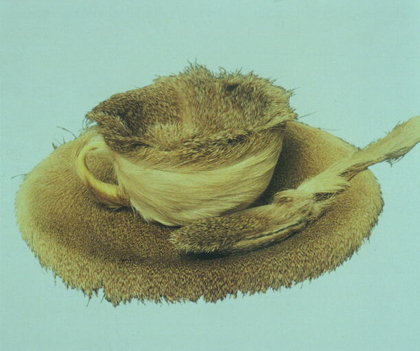Andrew Graham-Dixon on works by the First Lady of Surrealism in 'Meret Oppenheim: A Retrospective'
SHE CAME to Paris in 1930, at the age of 18, made good contacts in artistic circles and became the First Lady of Surrealism. She became, too, its first pin-up girl; Man Ray photographed her in 1933 and her image, nude, was soon gracing the pages of Minotaure, the leading art magazine of the day. Meret Oppenheim had arrived.
The products of Man Ray's photo-session line a corridor at the ICA, background to the main event, 'Meret Oppenheim: A Retrospective': Meret solarised, in graceful profile; Meret as bathing beauty, with cap but no costume; Meret as victim, looking up in melodramatic mock-horror as her hands are tied by a bald villain with a ridiculous, bushy beard. The last picture, in particular, reminds you that while Surrealism preached a theoretical liberation from bourgeois convention and the free play of (mostly erotic) imagination, the large majority of its practitioners were men, and their imaginings - however wilfully bizarre their manifestations - were of a fairly conventional, bourgeois, sado-masochistic variety.
Giacometti's Woman with her Throat Cut; Picasso's fiendish, castratory bathers; Magritte's The Rape, a face with nipples for eyes, belly button for nose and pubic triangle for mouth - the canonical images of Eros in 1920s and 1930s Paris spoke of peculiarly male fantasies and anxieties. Meret Oppenheim, a woman in the man's man's man's world of the Surrealists, hit back by producing what is probably the single most famous Surrealist object, the erotic icon of her era: Luncheon in Fur.
The genesis of this singular oddity was a conversation with Picasso at the Cafe Flore in 1936. Picasso admired Oppenheim's bracelet, a fur-covered metal tube, remarking that one could cover anything with fur. Oppenheim looked down at...


